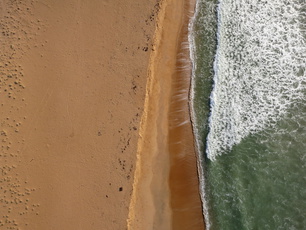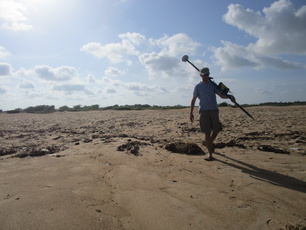Junior Research Group - Bridge Group with MARUM - University of Bremen (funding ended in 2018)
Coastal areas are one of the most rapidly evolving systems on Earth. The population density within 100 kilometers of the coastline is nearly 3 times higher than the global average density and 10% of the human population is living less than 10 meters above sea level (especially in the tropical zones).
This explains why the evolution of coastal areas is perceived as a relevant problem in need of monitoring, defense or adaptation strategies. Common figures state that the worldwide percentage of beaches under erosion is ~70%.
Sea level rise and change in the frequency and intensity of storms are expected to exacerbate the problem, leading to both social and natural negative consequences.
The group has a twofold aim. First, it aims to investigate past interglacials, moments when the earth was warmer than today, in order to gather the elevation of former sea levels and, ultimately, polar ice sheets sensitivity to warmer climates. This work is carried out in collaboration with geologists, ecologists, geophysicists and ice modelers.
Second, the group investigates rates and causes of coastal changes at different time scales in order to understand the sensitivity of different areas to coastal erosion, or to extreme wave events.
This work is carried out in collaboration with geologists, sedimentologists, Unmanned Aerial Vehicle and GIS experts and hydrodynamic modelers.
Completed research
The Sea Level and Coastal Changes (SLCC) group was a joint research group between MARUM (University of Bremen) and the Leibniz Centre for Tropical Marine Research (ZMT). The group lasted five years as initially planned (March 2014 to March 2019). In five years, the group published more than 40 papers in peer-reviewed international journals. The group uses modeling and innovative field survey techniques to answer pressing questions related to the Earth’s past and future. Highlights in the last 3 years include the study of past “superstorms” (published in PNAS and reported, among others, by the Washington Post), unraveling the future of waves on coral reefs (published in Science Advances and widely reported by international media) and the pioneering use of drones for coral reef studies (published in Coral Reefs and widely reported by German and International press, radio and TV).
Current tasks
The SLCC group leader (Dr. A. Rovere) is now a researcher at MARUM, where he leads an ERC Starting Grant. He continues to collaborate with ZMT, in particular on the topic of drones applied to the study of tropical areas. The flexibility of the drone technology allows studying coastal environments under a new perspective, substantially complementing the data that can be obtained via traditional techniques. At ZMT, the technology is applied to study coral reefs, mangrove forests and beach environments in different tropical countries. Current tasks include: i) the study of the potential of consumer-grade drones for conservational purposes in remote protected areas in Colombia; ii) the use of multispectral drone sensors to study the health of mangroves in Fiji; iii) the improvement of 3d reconstruction of coral reefs from drones in the Caribbean Sea and Maldives to support hydrodynamic studies. The demand in applying the drone technique in several fields is rising, and ZMT will continue to research new applications and will keep up to date with drone regulations in tropical countries.
Group page at MARUM: https://www.marum.de/en/about-us/Sea-Level-and-coastal-changes.html
Alessio Rovere's personal website. Link https://alerov.weebly.com/
WARMCOASTS project: http://warmcoasts.eu/index.html






